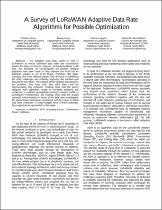JavaScript is disabled for your browser. Some features of this site may not work without it.
- ResearchSpace
- →
- Research Publications/Outputs
- →
- Conference Publications
- →
- View Item
| dc.contributor.author |
Lehong, C

|
|
| dc.contributor.author |
Isong, B

|
|
| dc.contributor.author |
Lugayizi, F

|
|
| dc.contributor.author |
Abu-Mahfouz, Adnan MI

|
|
| dc.date.accessioned | 2021-02-18T09:26:23Z | |
| dc.date.available | 2021-02-18T09:26:23Z | |
| dc.date.issued | 2020-11 | |
| dc.identifier.citation | Lehong, C., Isong, B., Lugayizi, F. & Abu-Mahfouz, A.M. 2020. A survey of LoRaWAN adaptive data rate algorithms for possible optimization. http://hdl.handle.net/10204/11793 . | en_ZA |
| dc.identifier.isbn | 978-1-7281-9520-9 | |
| dc.identifier.isbn | 978-1-7281-9521-6 | |
| dc.identifier.uri | http://hdl.handle.net/10204/11793 | |
| dc.description.abstract | The Adaptive Data Rate (ADR) is used in LoRaWAN to ensure optimized data rates and transmission powers for static end devices. However, its implementation is still new, and therefore, its functionalities are limited. Multiple proposals have been made to help improve the ADR but an optimum solution is yet to be found. Therefore, this paper surveyed nine most relevant papers with the goal of identifying the ADR challenges and critically analyzing the solutions put forward to solve them. The critique of the solutions was based on the problems they solve, how they solve them, and the improvements they achieved. Findings show that the poorly designed ADR algorithm results in increased collisions and unfairness in collision probabilities amongst network traffic in LoRaWAN. Furthermore, the findings show that the studies surveyed had limitations in terms of the data rates investigated, the transmission parameters considered, and the region in which they were conducted. To help mitigate some of these challenges, few suggestions are presented in this paper. | en_US |
| dc.format | Fulltext | en_US |
| dc.language.iso | en | en_US |
| dc.relation.uri | DOI: 10.1109/IMITEC50163.2020.9334144 | en_US |
| dc.relation.uri | https://ieeexplore.ieee.org/document/9334144 | en_US |
| dc.relation.uri | https://ieeexplore.ieee.org/xpl/conhome/9334048/proceeding | en_US |
| dc.source | 2nd International Multidisciplinary Information Technology and Engineering Conference (IMITEC), Kimberley, South Africa, 25-27 November 2020 | en_US |
| dc.subject | Adaptive data rate | en_US |
| dc.subject | ADR | en_US |
| dc.subject | Collisions | en_US |
| dc.subject | Long Range Wide Area Network | en_US |
| dc.subject | LoRaWAN | en_US |
| dc.subject | Spreading factor | en_US |
| dc.subject | Transmission power | en_US |
| dc.title | A survey of LoRaWAN adaptive data rate algorithms for possible optimization | en_US |
| dc.type | Conference Presentation | en_US |
| dc.description.pages | 9pp | en_US |
| dc.description.note | Copyright: 2020 IEE. This is the preprint version of the work. | en_US |
| dc.description.cluster | Next Generation Enterprises & Institutions | |
| dc.description.impactarea | EDTRC Management | en_US |
| dc.identifier.apacitation | Lehong, C., Isong, B., Lugayizi, F., & Abu-Mahfouz, A. M. (2020). A survey of LoRaWAN adaptive data rate algorithms for possible optimization. http://hdl.handle.net/10204/11793 | en_ZA |
| dc.identifier.chicagocitation | Lehong, C, B Isong, F Lugayizi, and Adnan MI Abu-Mahfouz. "A survey of LoRaWAN adaptive data rate algorithms for possible optimization." <i>2nd International Multidisciplinary Information Technology and Engineering Conference (IMITEC), Kimberley, South Africa, 25-27 November 2020</i> (2020): http://hdl.handle.net/10204/11793 | en_ZA |
| dc.identifier.vancouvercitation | Lehong C, Isong B, Lugayizi F, Abu-Mahfouz AM, A survey of LoRaWAN adaptive data rate algorithms for possible optimization; 2020. http://hdl.handle.net/10204/11793 . | en_ZA |
| dc.identifier.ris | TY - Conference Presentation AU - Lehong, C AU - Isong, B AU - Lugayizi, F AU - Abu-Mahfouz, Adnan MI AB - The Adaptive Data Rate (ADR) is used in LoRaWAN to ensure optimized data rates and transmission powers for static end devices. However, its implementation is still new, and therefore, its functionalities are limited. Multiple proposals have been made to help improve the ADR but an optimum solution is yet to be found. Therefore, this paper surveyed nine most relevant papers with the goal of identifying the ADR challenges and critically analyzing the solutions put forward to solve them. The critique of the solutions was based on the problems they solve, how they solve them, and the improvements they achieved. Findings show that the poorly designed ADR algorithm results in increased collisions and unfairness in collision probabilities amongst network traffic in LoRaWAN. Furthermore, the findings show that the studies surveyed had limitations in terms of the data rates investigated, the transmission parameters considered, and the region in which they were conducted. To help mitigate some of these challenges, few suggestions are presented in this paper. DA - 2020-11 DB - ResearchSpace DP - CSIR J1 - 2nd International Multidisciplinary Information Technology and Engineering Conference (IMITEC), Kimberley, South Africa, 25-27 November 2020 KW - Adaptive data rate KW - ADR KW - Collisions KW - Long Range Wide Area Network KW - LoRaWAN KW - Spreading factor KW - Transmission power LK - https://researchspace.csir.co.za PY - 2020 SM - 978-1-7281-9520-9 SM - 978-1-7281-9521-6 T1 - A survey of LoRaWAN adaptive data rate algorithms for possible optimization TI - A survey of LoRaWAN adaptive data rate algorithms for possible optimization UR - http://hdl.handle.net/10204/11793 ER - | en_ZA |
| dc.identifier.worklist | 24124 | en_US |






